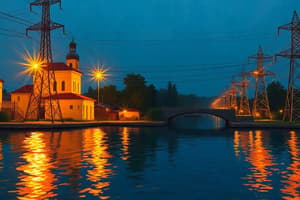Podcast
Questions and Answers
Which part of power distribution involves managing electric energy from generation points through transmission lines to final users?
Which part of power distribution involves managing electric energy from generation points through transmission lines to final users?
- Distribution Center
- Substation
- Generation
- Transmission (correct)
What is the purpose of transformers in power distribution?
What is the purpose of transformers in power distribution?
- Generating electric energy
- Regulating electric voltage (correct)
- Maintaining distribution centers
- Controlling substations
Which source is NOT typically used for generating electric energy in power distribution?
Which source is NOT typically used for generating electric energy in power distribution?
- Gasoline (correct)
- Coal
- Wind
- Water
Which part of the power distribution process involves distributing electricity within the premises of commercial and residential establishments?
Which part of the power distribution process involves distributing electricity within the premises of commercial and residential establishments?
What is the function of substations in power distribution?
What is the function of substations in power distribution?
What is the purpose of a substation in the power grid network?
What is the purpose of a substation in the power grid network?
How do hot wires function in a substation?
How do hot wires function in a substation?
What is the function of distribution centers in the power grid?
What is the function of distribution centers in the power grid?
How is power typically delivered to homes and businesses?
How is power typically delivered to homes and businesses?
Which profession ensures stable foundations for power infrastructure?
Which profession ensures stable foundations for power infrastructure?
How does coordination among different professions benefit power distribution?
How does coordination among different professions benefit power distribution?
Flashcards are hidden until you start studying
Study Notes
Electricians and Power Distribution
Electricians play a crucial role in our lives by ensuring that we have access to safe and reliable electricity. They install and maintain electrical systems in homes, businesses, and other structures, and they're responsible for bringing power into buildings. This is particularly important when it comes to power distribution, which involves managing, controlling, and delivering electric energy from generation points through transmission lines to final users. It also includes distributing electricity within the premises of commercial and residential establishments.
Understanding Power Distribution
Power distribution consists of four main parts: Generation, Transmission, Substation, and Distribution Center. Each part plays a significant role in getting power where it needs to go. Let's break them down further:
-
Generation: This process starts with generating electric energy using different sources such as water, coal, nuclear material, oil, gas, wind, sun, etc.. These generators convert mechanical energy extracted from these resources into electric energy via turbines driven by steam generated by heating a primary fluid.
-
Transmission: After being produced, this electric energy must travel great distances before reaching its destination. That's why transformers step up the voltage to levels suitable for transmission over high-voltage lines. At substations along the line, the voltage can be stepped back down for delivery to customers. In some cases, like with solar panels installed directly on rooftops, there might not even be any utility-provided power available - making local distribution more challenging.
-
Substations: A substation is an essential component of the power grid network. Its purpose is to connect three wires: two hot wires and one neutral wire. Each hot wire carries half the total current going out; one takes twice what's used (the maximum) while the second takes half again. At their simplest level, each subsystem has switches to disconnect loads if necessary.
-
Distribution Centers: Finally, power reaches your home and business through overhead cables (aerial borne medium), underground cables, or both under various designs known as Overhead Service or Overhead Mains. Distribution centers may have several different configurations depending on the location. They function similarly to how street lights work - where you turn them on/off from central control stations rather than individual homes.
How Different Professions Are Involved
While the general public usually only sees the end result - receiving electricity - many people contribute behind the scenes. Electrical engineers design all equipment involved in power generation, transmission, and distribution. Civil, mechanical, and structural engineers ensure stable foundations, towers, poles, and bridges are built securely so electric supply doesn’t get interrupted due to natural events. Telecommunication professionals set up communication channels between utilities so power system operators can monitor everything remotely.
Each profession mentioned here works hand-in-hand with others because efficient operation relies on coordination across disciplines. For instance, civil engineering ensures proper road construction for laying fibre optic cables within a few meters off roadsides (as per international standards).
In conclusion, understanding the intricate relationship among professions and key components of power infrastructure starts with knowing how your own electricity gets delivered. From generation to transmission, substations, and distribution centers, every piece contributes to providing us with uninterrupted service.
Studying That Suits You
Use AI to generate personalized quizzes and flashcards to suit your learning preferences.




